belt Lancia Ypsilon 2001 Owner handbook (in English)
[x] Cancel search | Manufacturer: LANCIA, Model Year: 2001, Model line: Ypsilon, Model: Lancia Ypsilon 2001Pages: 191, PDF Size: 2.45 MB
Page 10 of 191
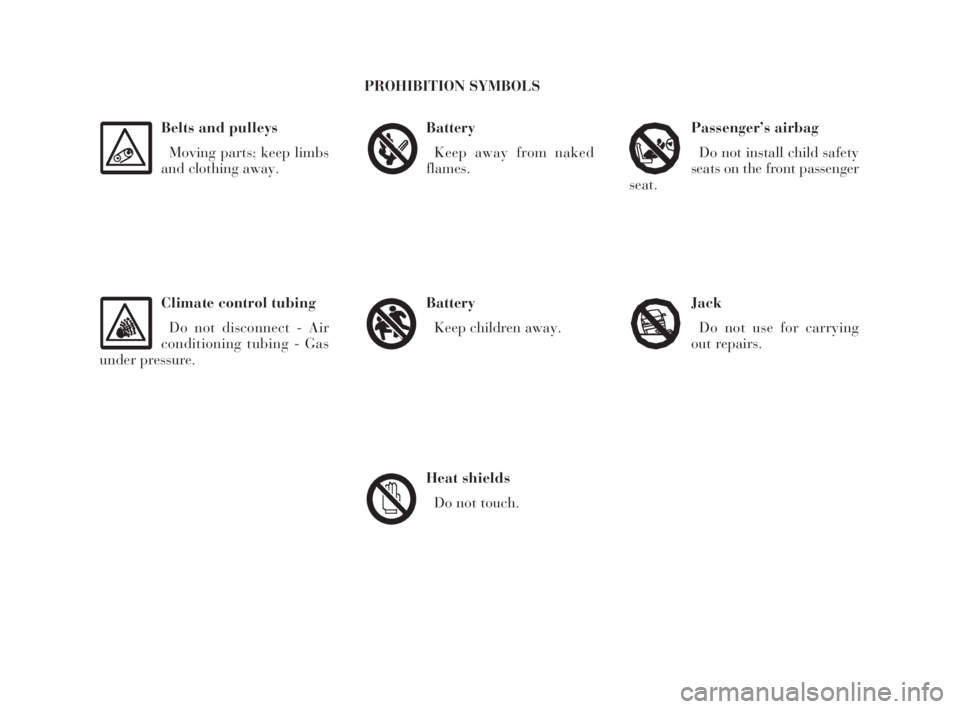
G
Belts and pulleys
Moving parts; keep limbs
and clothing away.
Climate control tubing
Do not disconnect - Air
conditioning tubing - Gas
under pressure.
Battery
Keep away from naked
flames.
Battery
Keep children away.
Heat shields
Do not touch.
Passenger’s airbag
Do not install child safety
seats on the front passenger
seat.
Jack
Do not use for carrying
out repairs.
PROHIBITION SYMBOLS
4C001-067 ING 11-03-2008 11:57 Pagina 7
Page 13 of 191
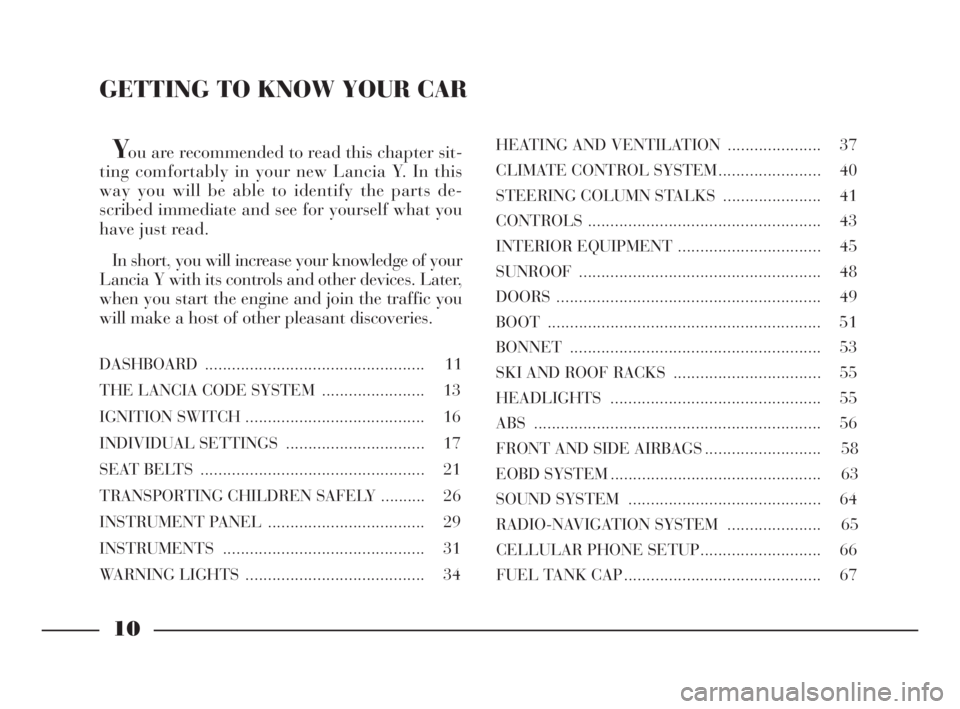
You are recommended to read this chapter sit-
ting comfortably in your new Lancia Y. In this
way you will be able to identify the parts de-
scribed immediate and see for yourself what you
have just read.
In short, you will increase your knowledge of your
Lancia Y with its controls and other devices. Later,
when you start the engine and join the traffic you
will make a host of other pleasant discoveries.
DASHBOARD................................................. 11
THE LANCIA CODE SYSTEM....................... 13
IGNITION SWITCH ........................................ 16
INDIVIDUAL SETTINGS ............................... 17
SEAT BELTS .................................................. 21
TRANSPORTING CHILDREN SAFELY .......... 26
INSTRUMENT PANEL ................................... 29
INSTRUMENTS............................................. 31
WARNING LIGHTS ........................................ 34HEATING AND VENTILATION ..................... 37
CLIMATE CONTROL SYSTEM....................... 40
STEERING COLUMN STALKS ...................... 41
CONTROLS.................................................... 43
INTERIOR EQUIPMENT ................................ 45
SUNROOF...................................................... 48
DOORS........................................................... 49
BOOT ............................................................. 51
BONNET........................................................ 53
SKI AND ROOF RACKS................................. 55
HEADLIGHTS............................................... 55
ABS ................................................................ 56
FRONT AND SIDE AIRBAGS.......................... 58
EOBD SYSTEM............................................... 63
SOUND SYSTEM ........................................... 64
RADIO-NAVIGATION SYSTEM..................... 65
CELLULAR PHONE SETUP........................... 66
FUEL TANK CAP ............................................ 67
10
G
GETTING TO KNOW YOUR CAR
4C001-067 ING 11-03-2008 11:57 Pagina 10
Page 24 of 191

21
G
SEAT BELTS
HOW TO USE THE SEAT BELTS
(for the front and back side seats)
(fig. 16)
Pull the seat belt out gently; if the
belt jams, let it rewind for a short
stretch, then pull it out again without
jerking.
To fasten the seat belts, take the
tongue of fastener Aand push it into
buckleBuntil you hear it click.The lower part of the front seat belts
slides on a bar to make it easier for
you to get hold of the belt when
putting it on.
Press button Cto unfasten the belts.
Guide the belt with your hand as it
rewinds to prevent it twisting.
The belt unwinds from the reel and
automatically adjusts to fit the pas-
senger’s body, allowing him or her to
move in complete freedom. When the
car is parked on a slope the reel may
lock. This is quite normal.
The reel mechanism also prevents
the webbing coming out when it is
jerked or if the car brakes sharply, is
in a collision or when taking bends at
high speed.ADJUSTING THE FRONT SEAT
BELT HEIGHT (fig. 17)
For maximum safety,
keep the back of your seat
upright, lean back into it
and make sure the seat belt fits
closely across your chest and hips.
fig. 17
P4C00050
Make the height adjust-
ment when the car is sta-
tionary.
Always adjust the height of the seat
belt to fit the person wearing it. This
could greatly reduce the risk of injury
in the case of collision.
fig. 16
P4C00397
4C001-067 ING 11-03-2008 11:57 Pagina 21
Page 25 of 191
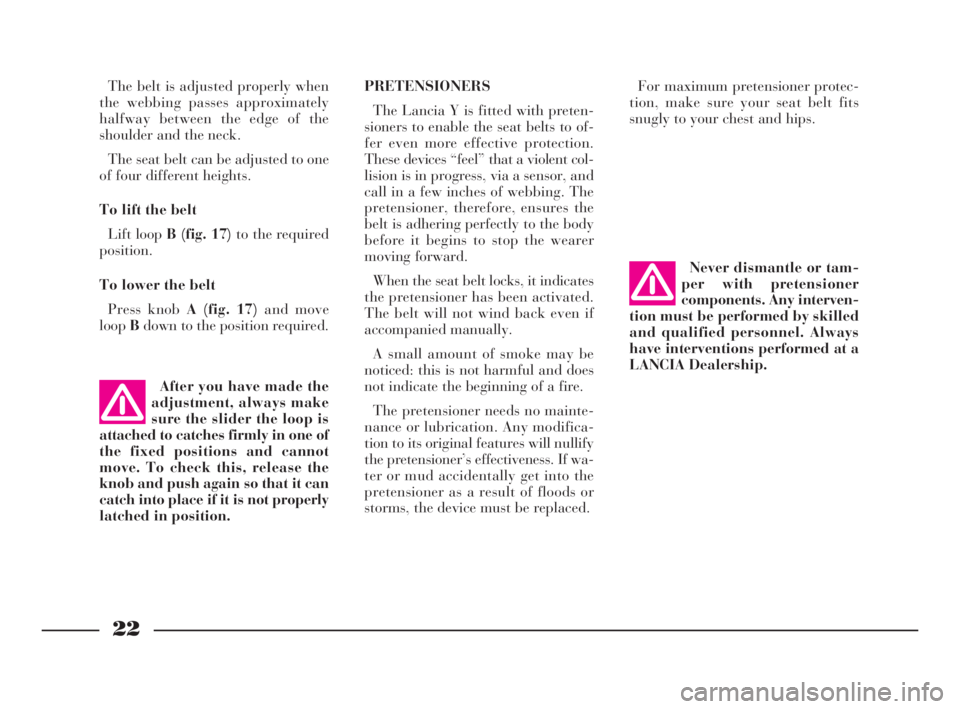
22
G
For maximum pretensioner protec-
tion, make sure your seat belt fits
snugly to your chest and hips.
Never dismantle or tam-
per with pretensioner
components. Any interven-
tion must be performed by skilled
and qualified personnel. Always
have interventions performed at a
LANCIA Dealership.PRETENSIONERS
The Lancia Y is fitted with preten-
sioners to enable the seat belts to of-
fer even more effective protection.
These devices “feel” that a violent col-
lision is in progress, via a sensor, and
call in a few inches of webbing. The
pretensioner, therefore, ensures the
belt is adhering perfectly to the body
before it begins to stop the wearer
moving forward.
When the seat belt locks, it indicates
the pretensioner has been activated.
The belt will not wind back even if
accompanied manually.
A small amount of smoke may be
noticed: this is not harmful and does
not indicate the beginning of a fire.
The pretensioner needs no mainte-
nance or lubrication. Any modifica-
tion to its original features will nullify
the pretensioner’s effectiveness. If wa-
ter or mud accidentally get into the
pretensioner as a result of floods or
storms, the device must be replaced. The belt is adjusted properly when
the webbing passes approximately
halfway between the edge of the
shoulder and the neck.
The seat belt can be adjusted to one
of four different heights.
To lift the belt
Lift loop B (fig. 17)to the required
position.
To lower the belt
Press knob A (fig. 17)and move
loopBdown to the position required.
After you have made the
adjustment, always make
sure the slider the loop is
attached to catches firmly in one of
the fixed positions and cannot
move. To check this, release the
knob and push again so that it can
catch into place if it is not properly
latched in position.
4C001-067 ING 11-03-2008 11:57 Pagina 22
Page 26 of 191
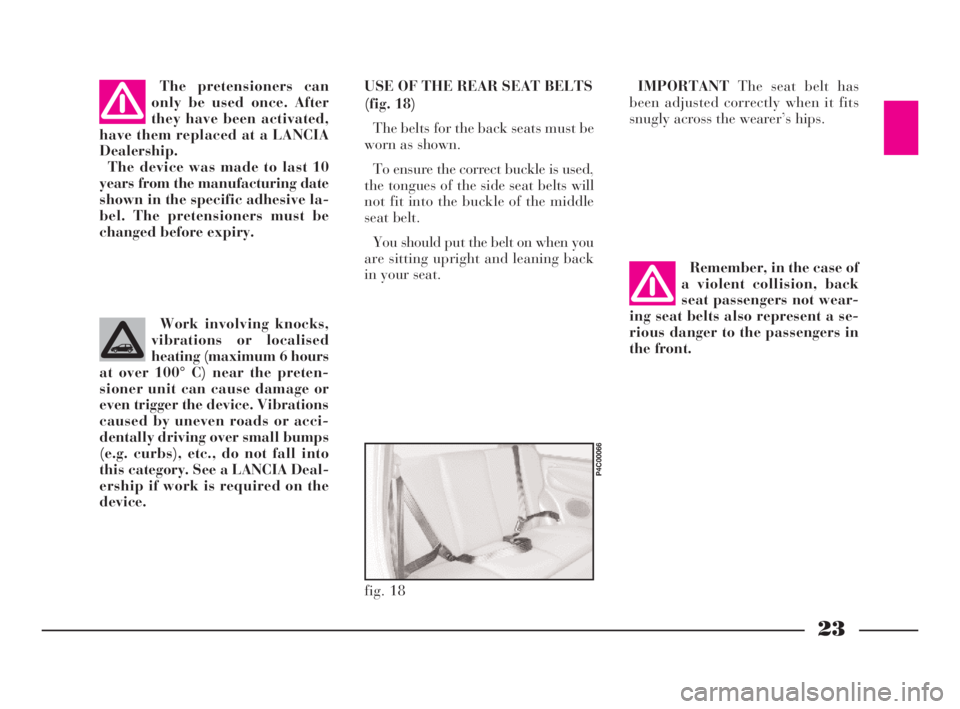
23
G
Work involving knocks,
vibrations or localised
heating (maximum 6 hours
at over 100° C) near the preten-
sioner unit can cause damage or
even trigger the device. Vibrations
caused by uneven roads or acci-
dentally driving over small bumps
(e.g. curbs), etc., do not fall into
this category. See a LANCIA Deal-
ership if work is required on the
device.The pretensioners can
only be used once. After
they have been activated,
have them replaced at a LANCIA
Dealership.
The device was made to last 10
years from the manufacturing date
shown in the specific adhesive la-
bel. The pretensioners must be
changed before expiry.
Remember, in the case of
a violent collision, back
seat passengers not wear-
ing seat belts also represent a se-
rious danger to the passengers in
the front. USE OF THE REAR SEAT BELTS
(fig. 18)
The belts for the back seats must be
worn as shown.
To ensure the correct buckle is used,
the tongues of the side seat belts will
not fit into the buckle of the middle
seat belt.
You should put the belt on when you
are sitting upright and leaning back
in your seat.IMPORTANTThe seat belt has
been adjusted correctly when it fits
snugly across the wearer’s hips.
fig. 18
P4C00066
4C001-067 ING 11-03-2008 11:57 Pagina 23
Page 27 of 191
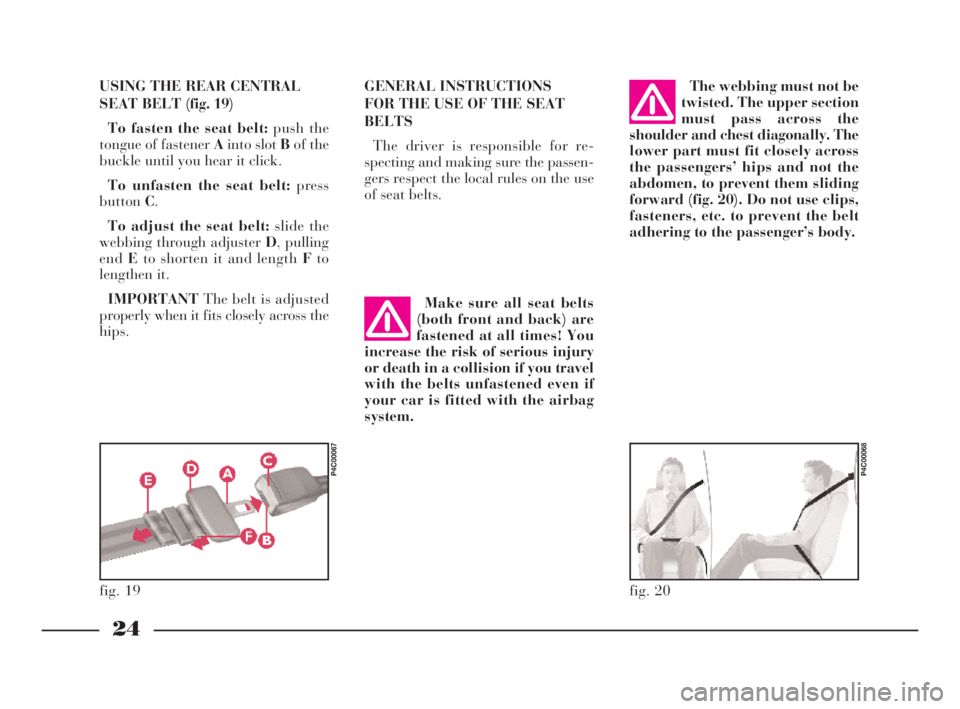
24
G
The webbing must not be
twisted. The upper section
must pass across the
shoulder and chest diagonally. The
lower part must fit closely across
the passengers’ hips and not the
abdomen, to prevent them sliding
forward (fig. 20). Do not use clips,
fasteners, etc. to prevent the belt
adhering to the passenger’s body.
Make sure all seat belts
(both front and back) are
fastened at all times! You
increase the risk of serious injury
or death in a collision if you travel
with the belts unfastened even if
your car is fitted with the airbag
system.
fig. 20
P4C00068
GENERAL INSTRUCTIONS
FOR THE USE OF THE SEAT
BELTS
The driver is responsible for re-
specting and making sure the passen-
gers respect the local rules on the use
of seat belts. USING THE REAR CENTRAL
SEAT BELT(fig. 19)
To fasten the seat belt: push the
tongue of fastener Ainto slot Bof the
buckle until you hear it click.
To unfasten the seat belt: press
buttonC.
To adjust the seat belt: slide the
webbing through adjuster D, pulling
endEto shorten it and length Fto
lengthen it.
IMPORTANTThe belt is adjusted
properly when it fits closely across the
hips.
fig. 19
P4C00067
4C001-067 ING 11-03-2008 11:57 Pagina 24
Page 28 of 191

25
G
Never travel with a child
sitting on a passenger’s lap
with a single seat belt to
protect them both (fig. 21).
fig. 21
P4C00173
Seat belts must also be worn by ex-
pectant mothers: the risk of injury in
the case of accident is much greater
for them, too, if they do not have a
seat belt on.
Of course, expectant mothers must
position the lower part of the belt very
low down so that it passes under the
stomach,(fig. 22). If the belt has undergone
serious strain, for example
following an accident, re-
place the belt with its anchorages,
the anchorage screws and the pre-
tensioner. Even if there is no visi-
ble damage, the resistance proper-
ties may have deteriorated.
fig. 22
P4C00069
HOW TO MAINTAIN
THE SEAT BELTS
IN GOOD WORKING ORDER
1)When wearing the seat belts, al-
ways ensure they are not twisted but
lie flat across the chest and hips and
ensure that they run easily and freely.
2)Following a serious accident, re-
place the belt being worn at the time,
even if it does not seem damaged.
3)When cleaning the belts, wash
them by hand with water and neutral
soap, rinse them and let them dry in
the shade. Do not use strong deter-
gents, bleach, colouring or any other
chemical substance that could weaken
the fibres.
4)Do not allow the reels to get wet:
they are only guaranteed to work
properly if they remain dry. SEVERE DANGER:
if the car has a pas-
senger airbag, do
not place the child seat on the
front seat.
4C001-067 ING 11-03-2008 11:57 Pagina 25
Page 29 of 191
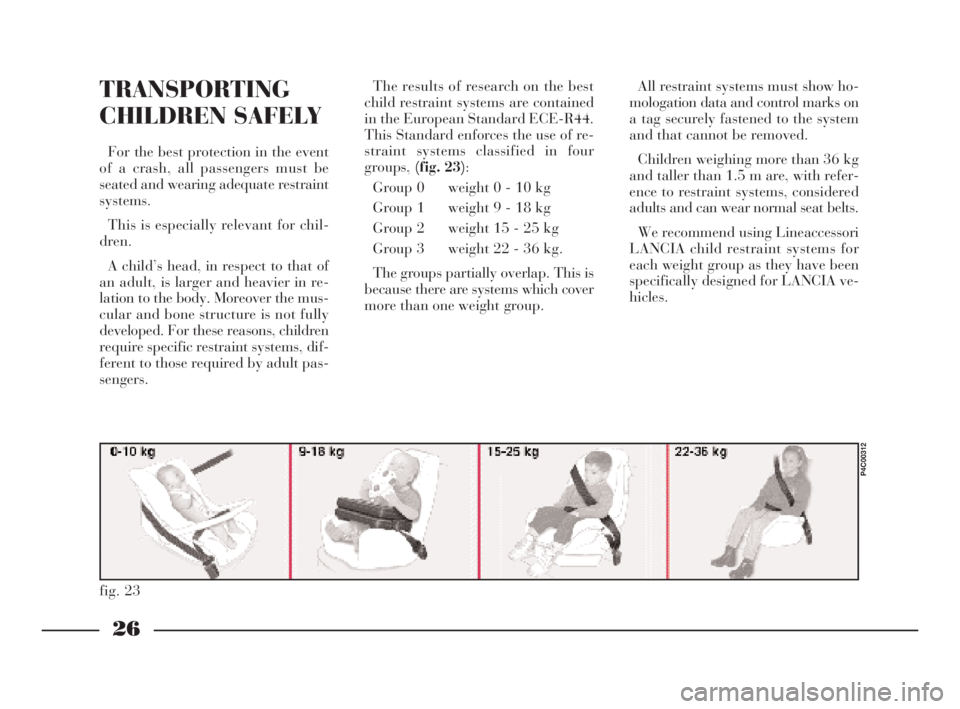
26
G
fig. 23
P4C00312
TRANSPORTING
CHILDREN SAFELY
For the best protection in the event
of a crash, all passengers must be
seated and wearing adequate restraint
systems.
This is especially relevant for chil-
dren.
A child’s head, in respect to that of
an adult, is larger and heavier in re-
lation to the body. Moreover the mus-
cular and bone structure is not fully
developed. For these reasons, children
require specific restraint systems, dif-
ferent to those required by adult pas-
sengers.The results of research on the best
child restraint systems are contained
in the European Standard ECE-R44.
This Standard enforces the use of re-
straint systems classified in four
groups,(fig. 23):
Group 0 weight 0 - 10 kg
Group 1 weight 9 - 18 kg
Group 2 weight 15 - 25 kg
Group 3 weight 22 - 36 kg.
The groups partially overlap. This is
because there are systems which cover
more than one weight group.All restraint systems must show ho-
mologation data and control marks on
a tag securely fastened to the system
and that cannot be removed.
Children weighing more than 36 kg
and taller than 1.5 m are, with refer-
ence to restraint systems, considered
adults and can wear normal seat belts.
We recommend using Lineaccessori
LANCIA child restraint systems for
each weight group as they have been
specifically designed for LANCIA ve-
hicles.
4C001-067 ING 11-03-2008 11:57 Pagina 26
Page 30 of 191
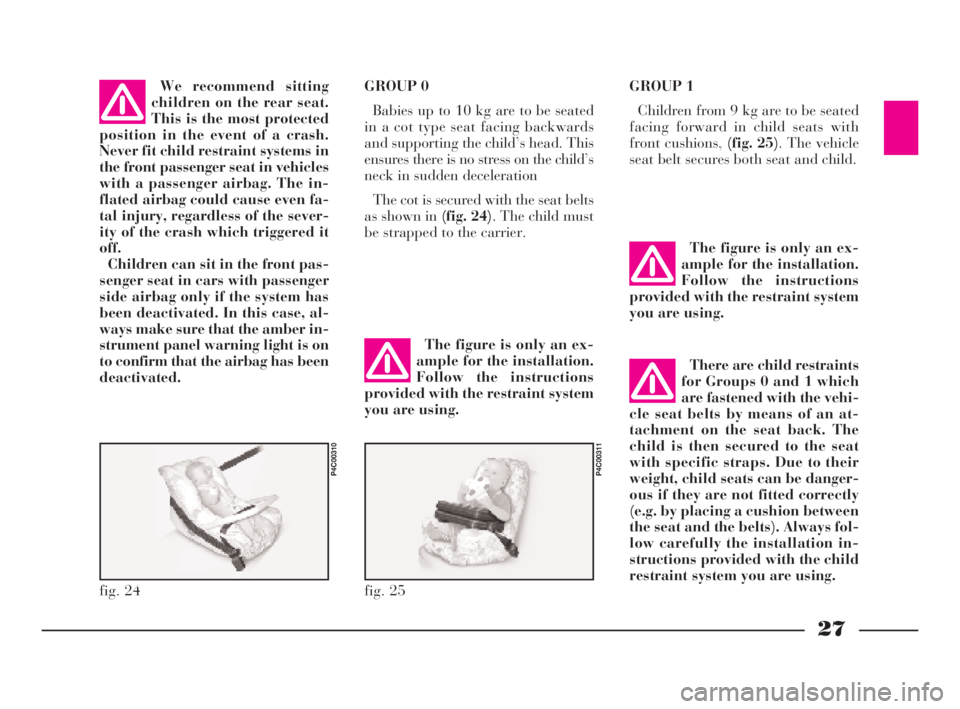
27
G
fig. 24
P4C00310
fig. 25
P4C00311
We recommend sitting
children on the rear seat.
This is the most protected
position in the event of a crash.
Never fit child restraint systems in
the front passenger seat in vehicles
with a passenger airbag. The in-
flated airbag could cause even fa-
tal injury, regardless of the sever-
ity of the crash which triggered it
off.
Children can sit in the front pas-
senger seat in cars with passenger
side airbag only if the system has
been deactivated. In this case, al-
ways make sure that the amber in-
strument panel warning light is on
to confirm that the airbag has been
deactivated.GROUP 0
Babies up to 10 kg are to be seated
in a cot type seat facing backwards
and supporting the child’s head. This
ensures there is no stress on the child’s
neck in sudden deceleration
The cot is secured with the seat belts
as shown in (fig. 24). The child must
be strapped to the carrier.GROUP 1
Children from 9 kg are to be seated
facing forward in child seats with
front cushions, (fig. 25). The vehicle
seat belt secures both seat and child.
The figure is only an ex-
ample for the installation.
Follow the instructions
provided with the restraint system
you are using.
The figure is only an ex-
ample for the installation.
Follow the instructions
provided with the restraint system
you are using.
There are child restraints
for Groups 0 and 1 which
are fastened with the vehi-
cle seat belts by means of an at-
tachment on the seat back. The
child is then secured to the seat
with specific straps. Due to their
weight, child seats can be danger-
ous if they are not fitted correctly
(e.g. by placing a cushion between
the seat and the belts). Always fol-
low carefully the installation in-
structions provided with the child
restraint system you are using.
4C001-067 ING 11-03-2008 11:57 Pagina 27
Page 31 of 191

28
G
fig. 26
P4C00313
fig. 27
P4C00314
GROUP 2
Children from 15 kg can be secured
directly with the vehicle seat belts.
The child seat has the purpose of po-
sitioning the child correctly with re-
spect to the seat belt so that the diag-
onal section crosses the child’s chest
(never the child’s throat) and the hor-
izontal section fits snugly on the
child’s hips (and not on the child’s
abdomen)(fig. 26).GROUP 3
Children from 22 kg up only require
a cushion to lift them (fig. 27). The
size of the child’s chest no longer re-
quires a support to space the child’s
back from the seat back.
Children taller than 1.5 m can wear
seat belts like adults.
To sum up the safety precautions
to follow when transporting chil-
dren:
1)Child restraint systems should be
installed on the rear seat as this is the
most protected area in the car in the
event of a crash.
2)Children must neverbe seated in
the front passenger seat in cars with
passenger seat airbag.3)Always check that the amber in-
strument panel warning light comes
on after deactivating the passenger
front airbag (in model/versions where
fitted).
4)Follow the instructions for fas-
tening the specific child restraint sys-
tem you are using. These must be
provided by the manufacturer. Keep
the child restraint system installation
instructions with the vehicle docu-
ments and this handbook. Never use
a second-hand child restraint system
without installation instructions.
5)Always check the seat belt is well
fastened by pulling the webbing.
6)The child restraint system is de-
signed for one child only. Never carry
two children in one restraint system.
7)Always check the seat belts do not
fit around the child’s neck.
8)While travelling do not let the
child sit incorrectly or release the belts.
9)Passengers should never carry
children on their laps. No-one, how-
ever strong they may be, can hold a
child in the event of a crash.
10)Replace the child restraint sys-
tem after an accident. The figure is only an ex-
ample for the installation.
Follow the instructions
provided with the restraint system
you are using.
4C001-067 ING 11-03-2008 11:57 Pagina 28